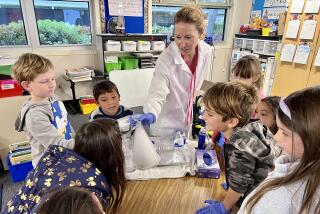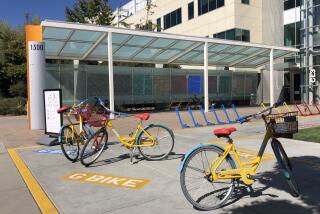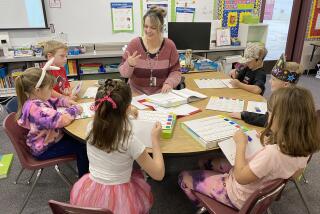Much of Education Research Found to Be Inadequate
- Share via
Much of what passes for research in education is not particularly useful, even in the view of those who do it.
True, educators say, new theories in education have resulted in some real improvements, notably in new techniques for teaching reading and writing and explaining science and mathematics to children. Investigations of longstanding educational problems and experiments with new technologies have also led to extracurricular reforms such as Head Start, a government-backed project designed to help poor children succeed in school, and Sesame Street, a television program that has captured the hearts and minds of preschool children for the last two decades.
But, overall, research into teaching and learning has not had nearly the effect on the schools that some educators might have hoped for.
Part of the problem has been money.
Because state governments spend so much educating students, they have little, if any, left over for figuring out how students might be better educated. For that reason, the job of supporting education research has been left in the hands of the federal government. But federal lawmakers, pressed to find ways to cut spending, have found education research an easy target.
The results of budget cutting have been clear. In the last 15 years, federal support for education research has dropped by 80%.
“One way to look at how dismal the situation is,” said Alexander W. Astin, an education professor at UCLA and one of the country’s foremost education researchers, “is to compare how much we spend on research for education with how much we spend on research on health care.
“For every dollar we spend in education research,” Astin estimates, “we spend about $1,000 in health research.
“This creates a kind of vicious circle. It is said that education research is not very good, therefore it is not funded. But when it is not funded, this drives many of the good researchers out of the field.”
Whatever the cause, said Derek Bok, president of Harvard University, the “prevailing view is that scholars have contributed little to improve practice in the schools.”
“Not that the field has lacked for effort. Many thousands of articles appear every year. Nevertheless, education journals are repeatedly described as filled with projects that are imperfectly designed, shoddily researched and poorly reasoned. Topics are often chosen on the basis of the social significance of the subject with little heed as to what questions are truly researchable. Methods of inquiry are frequently questionable and conclusions politically biased or only loosely related to the evidence.
“Because of such problems, one panel of experts reviewed a large number of articles and concluded that 40% should have been rejected outright and another 41% accepted only with revision,” Bok wrote in a report to the Harvard Board of Overseers last year.
The problems with education research projects parallel virtually all social studies research, said Judith E. Lanier, dean of Michigan State’s School of Education.
Self-conscious about their low status in the academic world, education researchers have tried to legitimize their work by using the same objective modes of inquiry devised for the natural sciences. Yet, in studying how people learn, they have found it impossible to control and isolate variables in the same way that, say, a chemist does in a laboratory experiment. Thus, education researchers admit that they have been left in something of a quandary.
For years, they avoided this difficulty by adopting an “objective” or so-called behaviorist view of human behavior--one espoused by such psychologists as E. L. Thorndike, Ivan Pavlov or B. F. Skinner, explained Merlin Wittrock, a UCLA professor of education.
Under this approach, students were seen as machines to be conditioned and programmed, and teachers were their programmers. As Wittrock is fond of saying, when the behaviorists entered the field of education “the mind got thrown out” of the schools. And schools of education began to emphasize the how-to aspects of managing discipline problems, preparing lesson plans and designing bulletin boards.
Beginning in the mid-1950s and increasing to full swing by 1965, the majority of university researchers began to take a different view of learning, said Wittrock, who is editor of the most recent edition of the “Handbook on Teaching,” a compendium of the latest research in the field of education.
Most often called “cognitive psychology,” the new approach has looked at such unquantifiable characteristics of learning as perception, motivation and attention.
In studying how students learn, Wittrock said, a behaviorist would walk into a classroom and observe students’ outward behavior. If a student was gazing out a window instead of looking at the blackboard, the assumption would be that he was not paying attention. A cognitive psychologist, however, would not jump to that conclusion. Instead, he would try to understand what the student had heard and how that information fit, or did not fit, with what he already knew about the subject and what he wanted, or did not want, to know.
“It could be that some students simply concentrate better when they look off in another direction,” Wittrock said. “It could be they aren’t paying attention. The point is you have to look at more than just their behavior to understand what is going on inside a students’ mind.”
Unbelievable Demonstrations
Wittrock himself has studied why elementary school children often have difficulty learning science concepts even when they are “proved” with real experiments or demonstrations in the classroom.
What he and other researchers have found, he said, is that “children often do not believe the demonstrations they see in school.” To students, the teacher is like a magician who “can make marvelous things happen that defy nature, but that do not represent events in the real world,” at least the world as a youngster knows it.
“Teaching is more than knowing a subject matter and presenting it in clear language,” Wittrock concluded. “Teaching involves knowing how students think, their preconceptions and misconceptions. . . . It involves learning what motivates students and what genuinely gets their attention and holds it.”
More to Read
Sign up for Essential California
The most important California stories and recommendations in your inbox every morning.
You may occasionally receive promotional content from the Los Angeles Times.










